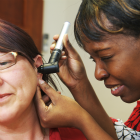Practices should offer to remove earwax in adult patients if it contributes to hearing loss or other symptoms, according to a draft guidance released by NICE.
The guidance says GP surgeries or community clinics should look into providing this service because it would reduce the need to refer patients to a specialist ear, nose and throat (ENT) service.
It also advised against manually pumping water into the ear through a syringe, warning that the ’design of the syringe and the inability to control the water pressure increases the risk of damage to the ear canal and tympanic membrane’.
Instead, it recommends using an electric irrigator after the pre-treatment wax softeners, which it claims is less harmful. Other methods such as microsuction and manual removal are acceptable.
It also recommends GPs:
- Refer adults with sudden or rapid onset of hearing loss that is not explained by external or middle ear causes.
- Refer immediately adults with acquired unilateral hearing loss and altered sensation or facial droop on the same side to an ear, nose and throat service or, if stroke is suspected, follow a local stroke referral pathway.
- Refer immediately adults with hearing loss who are immunocompromised and have otalgia (ear ache) with otorrhoea (discharge from the ear) that has not responded to treatment within 72 hours to an ear, nose and throat service.
- Consider a suspected cancer pathway referral to an ear, nose and throat service for adults of southeast Asian family origin with hearing loss and a unilateral middle ear effusion not associated with an upper respiratory tract infection.
- Consider referring people aged over 40 with unilateral hearing loss and otalgia that has lasted for more than three weeks to an ear, nose and throat service.
NICE director Professor Mark Baker said: ‘Our draft recommendations can help improve care for people with hearing loss through better management of earwax and referring people with symptoms to the right service at the right time.
‘We encourage those working in primary and specialist services, patients and stakeholders to comment on the proposed advice.’
The draft guidance is currently out for public consultation and will run until 12 January 2017.
Pulse October survey
Take our July 2025 survey to potentially win £1.000 worth of tokens












